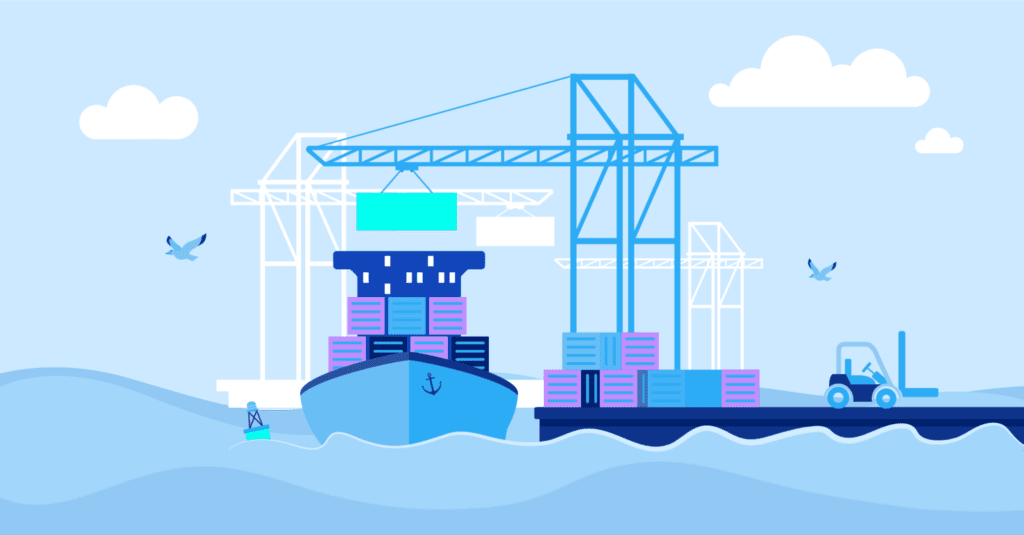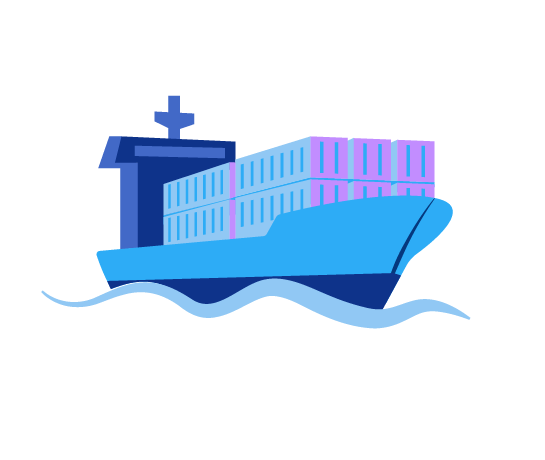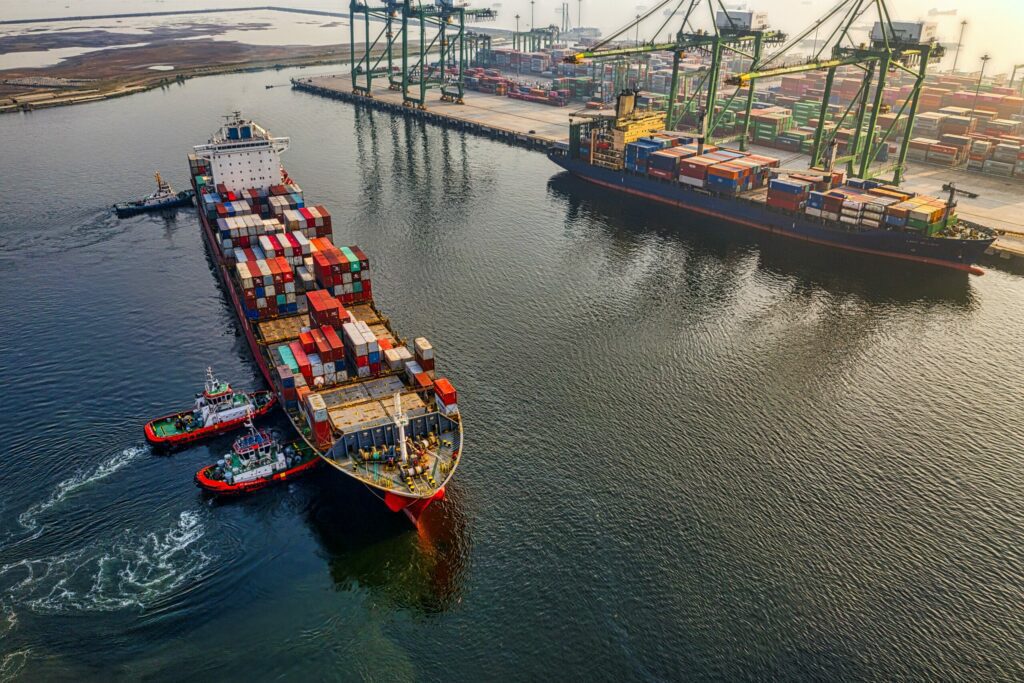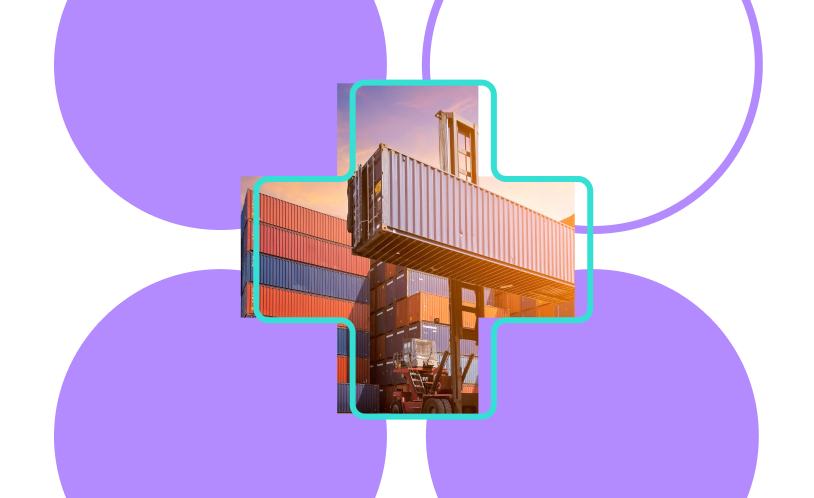Often called the world’s factory, China manufactures or assembles countless goods for export across many industries. Not surprisingly, China is also the world’s largest container market – and its ports play a crucial role in international trade operations.
With 150+ major ports and 1800+ minor ports, China is a central point for the global supply chain network. Popular ports in China include Shanghai, Ningbo, Qingdao, Tianjin, Guangzhou, Shenzhen, Yantian, Chiwan, and more.
Looking to ship from China? Here are some of the top Chinese ports, with information about their shipping operations, container handling capacity, and services.

Shanghai port
The world’s largest and busiest port, Shanghai manages more than 25% of global shipping. The port of Shanghai has maintained the lead in container throughput for 11 consecutive years, handling more than 43.6 million TEUs of cargo in 2020.
Established in 1842, the port is located in the Yangtze river delta and managed by Shanghai International Port Group (SIPG).
With a deep sea port and river port, Shanghai port oversees more than 2,000 vessels monthly. It offers integrated container services such as stevedoring, freight forwarding, storage and warehousing, distribution, port logistics, and cargo handling.
One of the leading trans-shipment hubs in China, the port of Shanghai has three container terminals: Yangshan, Wusongkou, and Waigaoqiao. It has a 20 km-long quay with 125 berths. Yangshan Port is the largest freight terminal in the world.

Shanghai port is equipped to manage all kinds of domestic and international cargo, but its main imports and exports include coal, metal, steel, petroleum, and machinery parts.
Despite supply chain disruptions and covid restrictions, Shanghai port had a container throughput of 22.5 million TEUs in the first half of 2022.
Ningbo port
Ningbo port is the second busiest port in China and the third-largest port in the world, with a throughput of 28.72 million TEUs in 2020. After the merger of Ningbo and Zhoushan ports in 2006, the port is officially called the port of Ningbo-Zhoushan.
Ningbo-Zhoushan port is the largest port in the world in terms of cargo throughput, reaching 1.224 billion tons of cargo in 2021 for the 13th consecutive year.
Located in the Zhejiang province in Eastern China, Ningbo port is a deep-water port connecting 260 container routes and 600 ports. It has 19 port areas which include Beilun (seaport), Zhenhai (estuary port), Ningbo (inland river port), Daxie, and Meishan.
Due to its location in the middle of the Chinese coastline, Ningbo is one of the most densely routed ports, especially for ocean containers transiting mainland China to and from the Pacific Ocean.
Ningbo port has 170 large berths above 10,000 tons, 100 extra-large deep-water berths above 50,000 tons, and 620 production berths. Thanks to its cargo facilities and container handling capacity, it is China’s largest transit port for ultra-large container vessels.
In terms of trade, Ningbo-Zhoushan port is the biggest transit base for iron ore and crude oil. It is also a prime storage and transportation hub for coal, liquid chemicals, and grains.
Looking to ship from China?
Shenzhen port
Shenzhen port connects South China to the rest of the country. It is the fourth-largest seaport in the world and the third-largest port in China, with a container throughput of 26.5 million TEUs in 2020.
Established in 1980, it is located in the Guangdong province in the Pearl river delta region. The port is managed by Shenzhen Yantian Port Holdings and Shenzhen Chiwan Wharf Holdings.
The Kowloon peninsula divides Shenzhen port into two parts. The western port is a deep-water port connecting to inland waterways, while the eastern port is a natural harbor for larger container vessels. The port is also connected to Hong Kong-Shenzhen Western Corridor (SWC) for moving freight via road.
It is classified into different zones based on types of cargo – with prime trade zones located in Yantian, Shekou, Chiwan, Nanshan, and Da Chan Bay.
Yantian port is the preferred port of call by big container vessels with an 8 km quay, 16 container berths, and 200 yard cranes. It is also the cheapest option for importing to the US.
Handling 550+ vessels monthly, Shenzhen port has 140 berths for managing container traffic. Top export items from Shenzhen include medical equipment, tableware, chemicals, machinery parts, and plastic molds.
The port of Shenzhen aims to prioritize container transportation and increase its cargo handling capacity to 33 million TEUs by 2025.

Port of Qingdao
Established in 1982, Qingdao (or Tsingtao) is the world’s seventh-largest port, clocking 22 million TEUs of container volume in 2020. It is located in Shandong province and provides one of the best natural harbors in the Yellow Sea for international trade.
The port of Qingdao has four major port areas: Qingdao Qianwan (container terminal), Huangdao or Guangdong (oil port area), Dongjiakou, and Dagang.
As a transshipment hub along the western Pacific coastline, the port areas are well-equipped to handle different types of containers and cargo, including crude oil, metal ore, and coal. Qingdao container terminal has special management and storage facilities for iron ore.
Due to its natural deep-water harbors and advanced technologies, the port of Qingdao provides world-class logistics services like stevedoring, port ancillary services, fully automated container terminals, single-machine unloading, storage, distribution, and other value-added services.
The port of Qingdao is part of the 21st century maritime silk route (MSR) to facilitate trade between Southeast Asia, Eastern Africa, the Mediterranean region, and Central Europe – on the same lines as the ancient silk route.
Port of Tianjin
The Port of Tianjin is the maritime gateway to the capital city of China, Beijing. Formerly known as the Port of Tanggu, it is the largest port in the northern part of China and the biggest man-made port in the world.
The port of Tianjin started as a non-containerized cargo terminal in 1968 and later expanded to provide container handling services in 1980. Currently, it is the world’s ninth-largest port for cargo throughput, with a handling capacity of 20 million TEUs annually.
Due to its geographical location at the juncture of the Beijing-Tianjin city belt and the economic trade region of Bohai Rim, the port is an international transshipment hub serving 14 provinces through 120+ container lines.
The port has four terminals for container handling. The Tianjin Port Container Terminal (TCT) is the largest terminal, with 13 container berths with a 3.5-km quay length. It also has special terminals for handling coal, coal-based fuel, metal ore, and crude oil. Other shipped goods include automobiles, liquid bulk, break bulk, and other general cargo.

The port of Tianjin is actively expanding its operations with automation and digital navigation systems. It recently introduced sea-rail transportation, increasing its annual handling capacity by 500,000 units of car equivalent.
Other major Chinese ports
Aside from the ports listed above, other popular ports in China include:
- Port of Guangzhou (5th largest port globally)
- Port of Hong Kong (8th largest port globally)
- Port of Xiamen
- Port of Dalian
- Port of Lianyungang
- Port of Yantai
- Port of Rizhao
- Port of Yingkou
- Port of Jinzhou
What’s next?
With the e-commerce industry thriving and expected to grow further in the coming decade, Chinese ports will continue to expand and advance in trade, services, and traffic. Increased containerized shipping and cargo from China will help fuel global economic growth.
READ MORE: Exporting from China and Importing to the US: A Guide



